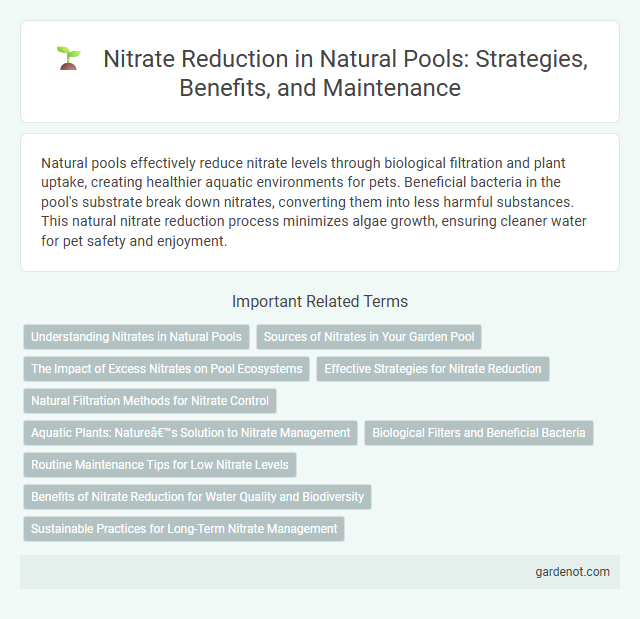Natural pools effectively reduce nitrate levels through biological filtration and plant uptake, creating healthier aquatic environments for pets. Beneficial bacteria in the pool's substrate break down nitrates, converting them into less harmful substances. This natural nitrate reduction process minimizes algae growth, ensuring cleaner water for pet safety and enjoyment.
Understanding Nitrates in Natural Pools
Nitrates in natural pools primarily originate from organic matter decomposition and surrounding soil runoff, influencing water quality and aquatic life. Effective nitrate reduction relies on biological filtration through plants and beneficial microbes that metabolize nitrates into harmless nitrogen gas. Monitoring nitrate levels below 10 mg/L ensures a balanced ecosystem, preventing algae overgrowth and maintaining clear, healthy water.
Sources of Nitrates in Your Garden Pool
Nitrates in your garden pool primarily originate from organic matter decomposition, fertilizer runoff, and animal waste entering the water. Excess nitrates promote algal blooms, disrupting the natural balance by depleting oxygen and harming aquatic plants. Effective nitrate reduction relies on minimizing these sources through careful garden management and natural filtration systems.
The Impact of Excess Nitrates on Pool Ecosystems
Excess nitrates in natural pools accelerate algae growth, leading to eutrophication and oxygen depletion that threatens aquatic life. Elevated nitrate levels disrupt the balance of microorganisms critical for maintaining water clarity and quality. Continuous monitoring and managing nitrate inputs are essential to preserving the health of pool ecosystems and preventing harmful algal blooms.
Effective Strategies for Nitrate Reduction
Effective strategies for nitrate reduction in natural pools include incorporating aquatic plants such as water lilies and reeds, which absorb nitrates directly from the water. Utilizing biofiltration systems with beneficial bacteria promotes the conversion of nitrates into nitrogen gas through denitrification processes. Regular water circulation and avoidance of excess organic matter further enhance nitrate removal efficiency and maintain optimal water quality.
Natural Filtration Methods for Nitrate Control
Natural filtration methods for nitrate control in natural pools rely on biofiltration through aquatic plants and beneficial microbes, which metabolize nitrate into less harmful nitrogen forms. Constructed wetlands and submerged macrophytes create an oxygen-rich environment that enhances denitrification processes, effectively reducing nitrate concentrations. Incorporating porous substrates and slow-flow systems improves microbial colonization, further optimizing nitrate removal and maintaining water quality.
Aquatic Plants: Nature’s Solution to Nitrate Management
Aquatic plants in natural pools play a crucial role in nitrate reduction by absorbing excess nitrates from the water, thereby preventing nutrient overload and algal blooms. Species such as water lilies and cattails enhance water quality through their root systems, which facilitate nitrate uptake and promote microbial activity that further breaks down nitrogen compounds. This biological process ensures a balanced aquatic ecosystem while maintaining crystal-clear water without reliance on chemical treatments.
Biological Filters and Beneficial Bacteria
Biological filters in natural pools effectively reduce nitrate levels by fostering the growth of beneficial bacteria that convert nitrates into nitrogen gas through the process of denitrification. These bacteria form biofilms on filter media, breaking down organic matter and preventing nitrate accumulation that can lead to algae blooms. Maintaining optimal conditions such as oxygen levels and temperature enhances bacterial activity and ensures continuous nitrate reduction for clear, balanced water.
Routine Maintenance Tips for Low Nitrate Levels
Routine maintenance for natural pools includes regular monitoring of nitrate levels using test kits to prevent algae growth and maintain water clarity. Incorporate aquatic plants such as water lilies and cattails that naturally absorb nitrates, enhancing the pool's biological filtration system. Periodic removal of organic debris and avoiding overfeeding fish helps minimize nitrate buildup and supports a balanced aquatic ecosystem.
Benefits of Nitrate Reduction for Water Quality and Biodiversity
Nitrate reduction in natural pools significantly improves water quality by preventing nutrient overload that causes harmful algal blooms and oxygen depletion. This process supports diverse aquatic ecosystems, enhancing habitat conditions for fish, amphibians, and beneficial microorganisms. Reduced nitrate levels promote balanced nutrient cycling, maintaining clear water and robust biodiversity essential for ecological stability.
Sustainable Practices for Long-Term Nitrate Management
Implementing natural wetland filtration and planting nitrate-absorbing vegetation significantly enhances nitrate reduction in natural pools, promoting eco-friendly water quality management. Regularly monitoring nitrate levels combined with controlled nutrient input from surrounding landscapes ensures sustained nitrate balance and prevents eutrophication. Integrating biofiltration systems with native plant species supports long-term nitrate removal while preserving the aquatic ecosystem's natural biodiversity.
Nitrate reduction Infographic

 gardenot.com
gardenot.com